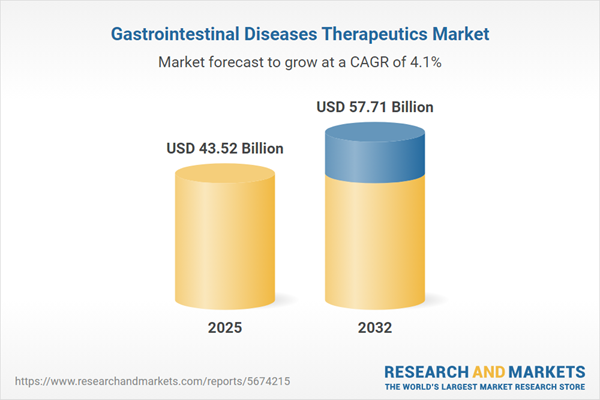Speak directly to the analyst to clarify any post sales queries you may have.
The gastrointestinal diseases therapeutics market is witnessing ongoing transformation, driven by evolving patient needs, innovation in treatments, and shifts in regulatory and economic environments. Senior decision-makers require precise intelligence to confidently navigate emerging risks, sustainable growth options, and new competitive realities within this dynamic sector.
Market Snapshot: Gastrointestinal Diseases Therapeutics Market
The Gastrointestinal Diseases Therapeutics Market grew from USD 41.82 billion in 2024 to USD 43.52 billion in 2025. It is expected to continue growing at a CAGR of 4.10%, reaching USD 57.71 billion by 2032.
Market expansion is propelled by shifts in demographics, rapid adoption of digital health technologies, and advancements in both targeted and systemic therapies. The sector is also shaped by evolving global trade policies, with specific downstream impacts on pricing, supply chain resilience, and access to advanced therapeutics across regions.
Scope & Segmentation
This report delivers in-depth coverage of the gastrointestinal diseases therapeutics landscape, providing a multi-layered view into current market dynamics, stakeholder strategies, and future opportunities.
- Indications: Acid-related disorders; infectious gastroenteritis (bacterial, parasitic, viral); inflammatory bowel diseases (e.g., Crohn’s disease, ulcerative colitis); irritable bowel syndromes (constipation-predominant, diarrhea-predominant, mixed type).
- Drug Classes: Aminosalicylates, several antibiotic types (including ciprofloxacin, metronidazole, rifaximin), antidiarrheals, antispasmodics, biologics, H2 receptor antagonists, laxatives, proton pump inhibitors.
- Routes of Administration: Oral, parenteral, topical therapies to accommodate diverse patient and clinical needs.
- Distribution Channels: Hospital pharmacy, online pharmacy, and general retail pharmacy avenues.
- Dosage Forms: Injectable solutions, oral powders, suspensions, and tablet or capsule options.
- End Users: Clinics, home healthcare environments, and hospital settings.
- Regional Coverage: Americas (including U.S., Canada, Mexico, Brazil, and additional Latin American markets); Europe, Middle East, and Africa (highlighting established and emerging countries); Asia-Pacific (China, India, Japan, and other high-growth economies).
- Key Companies: Profiles and developments tracked for leading pharmaceutical, biotechnology, and biologics organizations.
Key Takeaways for Senior Decision-Makers
- Treatment strategies are evolving, with biologics, microbiome therapies, and personalized medicine leading innovation beyond traditional symptom suppression.
- Digital health platforms are reshaping patient engagement and therapy adherence, especially through remote monitoring and telemedicine expansion, improving disease management at scale.
- Regulatory bodies increasingly rely on real-world evidence and rigorous safety benchmarks, adding complexity to approval pathways while creating opportunities for differentiation in value demonstration.
- Segmenting the market by indication, drug class, and route of administration remains essential for tailoring solutions to varied clinical demands and maximizing R&D investments.
- Competitive dynamics are sharpened by biosimilar entrants, regional expansion efforts, and collaborations between established pharmaceutical firms, biotechnology innovators, and contract partners.
Tariff Impact: Navigating the Changing U.S. Trade Environment
Recent U.S. tariff revisions have raised costs for key pharmaceutical ingredients and excipients. Manufacturers are responding through supply chain diversification, new supplier negotiations, and technology-enabled visibility tools, enhancing risk mitigation and maintaining access. Industry stakeholders are also adapting procurement strategies, and some are leveraging operational efficiencies or value-based contracts to manage reimbursement impacts and sustain innovation.
Methodology & Data Sources
This research is built on a comprehensive combination of secondary data analysis from scientific publications, regulatory records, and industry reports, complemented by primary interviews with key market participants. Expert validation and data triangulation ensure accuracy and relevancy for strategic decision-making.
Why This Report Matters
- Enables benchmarking against global peers by integrating coverage of clinical, regulatory, technological, and regional trends.
- Supports confident investment and expansion planning through detailed segmentation and robust analysis of supply chain and tariff-driven risk factors.
- Delivers actionable recommendations and competitive profiles crucial for shaping long-term growth strategies and enhancing market access.
Conclusion
This report equips senior leaders with the essential insights to navigate the complexity of gastrointestinal therapeutics. By leveraging its findings, organizations can prioritize patient-centric innovation, build resilient supply chains, and capitalize on emerging opportunities in a rapidly evolving global market.
Additional Product Information:
- Purchase of this report includes 1 year online access with quarterly updates.
- This report can be updated on request. Please contact our Customer Experience team using the Ask a Question widget on our website.
Table of Contents
3. Executive Summary
4. Market Overview
7. Cumulative Impact of Artificial Intelligence 2025
Companies Mentioned
The companies profiled in this Gastrointestinal Diseases Therapeutics market report include:- AbbVie Inc.
- Johnson & Johnson
- Takeda Pharmaceutical Company Limited
- Pfizer Inc.
- Novartis AG
- Ferring B.V.
- Gilead Sciences, Inc.
- Bausch Health Companies Inc.
- AstraZeneca PLC
- UCB SA
Table Information
| Report Attribute | Details |
|---|---|
| No. of Pages | 188 |
| Published | November 2025 |
| Forecast Period | 2025 - 2032 |
| Estimated Market Value ( USD | $ 43.52 Billion |
| Forecasted Market Value ( USD | $ 57.71 Billion |
| Compound Annual Growth Rate | 4.1% |
| Regions Covered | Global |
| No. of Companies Mentioned | 11 |









